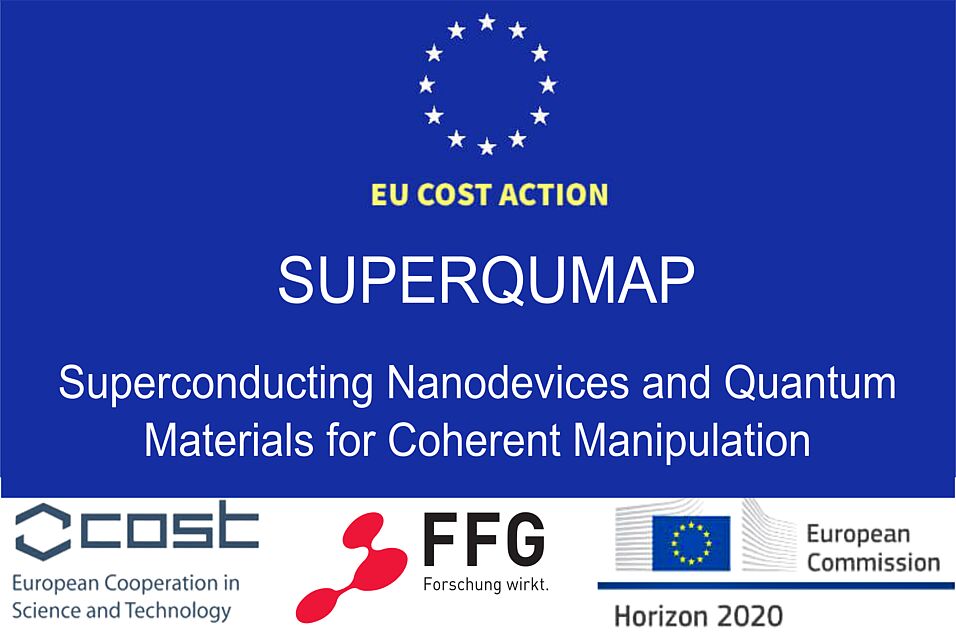PD Dr. habil. Oleksandr Dobrovolskiy and Prof. Dr. Wolfgang Lang are nominated as Management Committee Members from Austria
Researchers led by PD Dr. habil. Oleksandr V. Dobrovolskiy from the SuperSpin Lab at Nanomagnetism and Magnonics and Prof. Wolfgang Lang from the Electronic Properties of Materials group have been co-proposers of the network of researchers from over 25 EU countries pursuing the development of nanoscale superconducting devices for the manipulation of quantum phase, flux, and charge, among others. This collaborative project is funded by the European COST Action CA21144 "Superconducting Nanodevices and Quantum Materials for Coherent Manipulation" (SUPERQUMAP), which will continue through 05/10/2026.
Recent years have seen a surge in superconducting quantum electronics. However, current technologies face major difficulties in scaling of superconducting qubits. Exploring novel quantum materials and phenomena is an alternative route to improve superconducting devices and make a quantum leap in their stability and coherence. The Action will allow a collaborative approach joining together efforts and groups all over Europe, structured around three pathways, (i) the synthesis and characterization of quantum materials, (ii) the fabrication of sensors and devices exploiting novel superconducting functionalities, and (iii) the generation and coherent manipulation of novel states for superconducting quantum electronics.
The two groups from the Faculty of Physics will contribute to the COST Action by joint studies of the superconducting and magneto-resistive properties of nanoengineered systems with particular focus on the evolution of their current-carrying ability in consequence of exposures to ion and electron beams, microwave- and infrared-range photons, nanopatterning, and interactions with quasiparticle ensembles.
About COST Action CA21144 (SUPERQUMAP)
Superconductors are systems whose ground state is a macroscopic quantum coherent condensate characterized by vanishing electrical resistance, magnetic flux expulsion and quantization of circular currents. Using superconductors, one can build accelerators for radiotherapy, magnetic resonance imaging systems, trains, electrical power transmission lines, and many other devices. Furthermore, small superconducting circuits using Josephson junctions allow measuring tiny magnetic fields and are the basic building blocks of superconducting circuits, which hold the promise to disrupt computation by enabling the creation of quantum computers at large scale.
SUPERQUMAP aims to set-up an open and inclusive network with a clearly settled goal towards a significant technological breakthrough along the three main thrusts that will lead during next years to a significant progress beyond the state-of-the-art:
Quantum materials. The possibility to combine layers of different materials suggests a new materials-by-design approach that provides a fertile playground to realize and engineer new topological states. Similarly, the improved description and understanding of electronic interactions in some materials lead to interesting phenomena, such as spin-triplet superconductivity in ferromagnetic superconductors.
New functionalities for sensors and devices. Films and heterostructures provide a fertile ground for the appearance of novel superconducting features. By applying a gate voltage or slightly modifying some thin films, one can control the passage from a superconductor to an insulator. Furthermore, superconductor-based hybrid systems are interesting platforms for the exploration of vortex matter, nonequilibrium phenomena, bolometry and optical/infrared single-photon detection.
Building quantum systems. The progress in nanostructured superconducting hybrids opens a route to new controllable two-level systems, thus holding promise to considerably improve superconducting qubits. Including new quantum materials and fabrication methods enables radically different behavior for SQUIDs and other superconducting devices.

